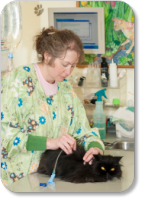Kidney disease in cats
Kidney disease commonly affects older cats, but it can strike at any age. It can develop suddenly (acute kidney disease) or gradually (chronic kidney disease). Fortunately, kidney disease is easily diagnosed, and your veterinarian can prescribe treatment to keep it under control.
Chronic kidney disease is more common. Symptoms appear gradually and include:
-
Increased thirst
-
Possible blood in the urine
-
Lethargy / appearance of depression
-
Vomiting
-
Bad breath
-
Increased urination
-
Decreased appetite / weight loss
-
Lack of grooming / poor coat
-
Diarrhea
If you spot any of these symptoms do NOT wait for them to become severe; contact your veterinarian immediately.
While there is no cure for kidney disease, it can easily be controlled with proper treatment. The earlier this condition is caught, the easier it is to treat.
CAT BREEDS prone to kidney disease are Exotic Long/Short Hairs, Himalayans and Persian. See complete chart.

Licensed Veterinary Technician, Laura Kramek, administers fluids to a patient.
Confirming kidney disease is easy
When feline kidney disease is suspected, a diagnosis is done with a blood test and urinalysis. When the kidneys are not functioning properly, substances called urea and creatinine build up in the body and will be detected. Blood may also be present in your cat’s urine.
Many cats with kidney disease also have hypertension (high blood pressure). The kidneys maintain the proper amount of fluid and salt in your cat’s body. They also produce hormones that help regulate blood pressure. Diseased kidneys often produce abnormal amounts of these hormones or inappropriately retain salt and water. The resulting fluid retention leads to hypertension.
Causes are varied
The chronic (gradual) form of kidney disease, common in cats, can occur as cats age and kidney became worn out or as a result of infection or an inherited defect. Often, however, the specific cause in an individual cat cannot be determined. The acute (sudden)form of kidney disease can be triggered by trauma, significant blood loss or the ingestion of toxins such as antifreeze. See more on potentially fatal hazards to your cat.

Our Hootie had kidney disease. The Cat Practice taught us how to
give him daily medication to alleviate nausea and pain. We also administered fluids. Once we got into a routine, it was easy. We would not trade the additional time this gave us with Hootie for anything.
– Linda Wasche, Sylvan Lake, MI
Treatment keeps kidney disease
under control
While there is no cure for kidney disease it's easily controlled with proper treatment which usually includes fluids, pain medication and anti-nausea drugs to make sure that kitty is comfortable. Prescription cat foods may also be recommended. The prognosis for each cat will vary depending upon the level of kidney damage and remaining kidney function.


